Holly Tucker's Blog, page 37
March 3, 2015
John Okey: Killer of the King
By Charles Spencer (Guest Contributor)
As a writer of history you never know when work you’ve completed previously will come back to help you.

Charles I
Three years ago I was on a website that I’m pretty sure is not among the most frequently visited – it’s called executedtoday.com – when the name of John Okey popped up. You would have to have trawled pretty deep in the waters of the English Civil War for that name to mean anything. But I had written a biography of Prince Rupert of the Rhine, who led the King’s army at its greatest defeat – our version of Gettysburg, I guess – and knew Okey had caused serious problems for my glamorous prince, that fateful June day in 1645.
It turned out that, on this macabre website, I had stumbled upon Okey’s final fate. For what had been written up was his excruciating death, exactly 350 years earlier: Okey and his two fellow condemned, I read, were being executed for being “killers of the King”. They had been among the 80 men who either prosecuted, judged, or oversaw the execution of King Charles I – a unique moment in British history, following our bloodiest ever conflict, between an autocratic monarch and a thrusting Parliament.
“Why”, I thought, “I never knew that was what happened to Okey!” And it made me think: who else was intimately involved in this astonishing event, when the king – who many believed to be semi-divine – was dispatched with an executioner’s axe, outside one of his finer royal palaces, on a freezing day in January, 1649?
This set me on a detective trail, identifying the killers, finding out why they did what they did, and discovering what happened to them once the dead king’s son very unexpectedly regained the British throne a decade later. I realized at once that I had stumbled on a thrilling tale of vengeance and betrayal, bravery and hope, despair and martyrdom – one that was played out across Britain, Continental Europe, and the American colonies of New England.
Indeed, so electrifying a plot has this true story from the past proved to be, that it is making it very hard to find a new subject that really grabs me – one that I will tackle with as much excitement as I encountered when researching and writing Killers of the King.
 A direct descendant of King Charles I, Charles Spencer (Ninth Earl Spencer) was educated at Eton College and obtained his degree in modern history at Magdalen College, Oxford. He is the author of four books, including The Sunday Times bestseller Blenheim: Battle for Europe (shortlisted for the British National Book Awards History Book of the Year) and Prince Rupert: The Last Cavalier. He lives at Althorp in England, the ancestral home of the Spencer family for more than 500 years and the childhood home of the late Diana, Princess of Wales.
A direct descendant of King Charles I, Charles Spencer (Ninth Earl Spencer) was educated at Eton College and obtained his degree in modern history at Magdalen College, Oxford. He is the author of four books, including The Sunday Times bestseller Blenheim: Battle for Europe (shortlisted for the British National Book Awards History Book of the Year) and Prince Rupert: The Last Cavalier. He lives at Althorp in England, the ancestral home of the Spencer family for more than 500 years and the childhood home of the late Diana, Princess of Wales.
March 2, 2015
Robinson Crusoe’s Parrot
By Adrienne Mayor (Regular Contributor)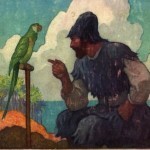
After two years alone on his desert island, and twenty years before he would meet Man Friday, a voice jolted Robinson Crusoe from a nap. Someone was calling out “Robin, Robin, Robin Crusoe! Poor Robin Crusoe! How did you come here? Where have you been? Why are you here?”
The startled sailor finally discovered the owner of the voice. It was Poll, his own pet parrot, who had disappeared after the shipwreck that stranded Crusoe on a remote tropical island. The parrot was repeating Robinson Crusoe’s own solitary lamentations.
The parrot and the lonely sailor were overjoyed to be reunited. Poll provided Crusoe with his only company until Man Friday appeared two decades later.
Daniel Defoe’s realistic novel of 1719, originally titled The Life and Strange Surprizing Adventures of Robinson Crusoe, Of York, Mariner: Who lived Eight and Twenty Years, all alone in an un-inhabited Island on the Coast of America, near the Mouth of the Great River of Oroonoque; Having been cast on Shore by Shipwreck, wherein all the Men perished but himself. With An Account how he was at last as strangely deliver’d by Pyrates, was probably partly influenced by Alexander Selkirk, a Scottish sailor who had been marooned for four years on a Pacific island off the coast of Chile. Some of the naturalistic details of Crusoe’s “Island of Despair” were likely based on Tobago in the Caribbean near the mouth of the Orinoco River in Venezuela.
Crusoe tamed two other parrots “native to the Brazils” and taught them to talk. There is no telling what sort of talking birds they were, since there are more than 70 species of Brazilian parrots, parakeets, and macaws. The pair never equaled Poll’s conversations but at least there were now four voices on the desert island. Crusoe was deeply grateful for Poll’s company, remarking that his old shipmate “spoke so familiarly and so articulately that it was very pleasant to me.”
Adrienne Mayor is a research scholar in Classics and History of Science, Stanford University, and the author of The Poison King: Mithradates, Rome’s Deadliest Enemy, a nonfiction finalist for the 2009 National Book Award, and The Amazons: Lives and Legends of Warrior Women across the Ancient World (2014).
March 1, 2015
No Scrubs: Breeding a Better Bull
By Gastropod (Regular Contributor)
Something extremely bizarre took place in the early decades of the twentieth century, inspired by a confluence of trends. Scientists had recently developed a deeper understanding of genetics and inherited traits; at the same time, the very first eugenics policies were being enacted in the United States. And, as the population grew, the public wanted cheaper meat and milk. As a result, in the 1920s, the USDA encouraged rural communities around the U.S. to put bulls on the witness stand—to hold a legal trial, complete with lawyers and witnesses and a watching public—to determine whether the bull was fit to breed.
No Scrubs: Breeding a Better Bull
In 1900, the average dairy cow in America produced 424 gallons of milk each year. By 2000, that figure had more than quadrupled, to 2,116 gallons. In this episode of Gastropod, we explore the incredible science that transformed the American cow into a milk machine—but we also uncover the disturbing history of prejudice and animal cruelty that accompanied it.
Livestock breeding was a normal part of American life at the dawn of the twentieth century, according to historian Gabriel Rosenberg. The U.S., he told Gastropod, was “still largely a rural and agricultural society,” and farm animals—and thus some more-or-less scientific forms of selective breeding—were ubiquitous in American life.
Meanwhile, the eugenics movement was on the rise. Founded by Charles Darwin’s cousin, Francis Galton, eugenics held that the human race could improve itself by guided evolution—which meant that criminals, the mentally ill, and others of “inferior stock” should not be allowed to procreate and pass on their defective genes. America led the way, passing the first eugenic policies in the world. By the Second World War, twenty-nine states had passed legislation that empowered officials to forcibly sterilize “unfit” individuals.
Combine the growing population, the desire for cheap meat and milk, and the increasing popularity of eugenics, and the result, Rosenberg said, was the “Better Sires: Better Stock” program, launched by the USDA in 1919. In an accompanying essay, ” Harnessing Heredity to Improve the Nation’s Live Stock,” the USDA’s Bureau of Animal Industry proclaimed that, each year, “a round billion dollars is lost because heredity has been permitted to work with too little control.” The implication: humans needed to take control—and stop letting inferior or “scrub” bulls reproduce!
Hear Ye! Hear Ye! Welcome to the Court of Bovine Justice
The “Better Sires: Better Stock” campaign included a variety of elements to encourage farmers to mate “purebred” rather than “scrub” or “degenerate” sires with their female animals. Anyone who pledged to only use purebred stock to expand their herd was awarded a handsome certificate. USDA field agents distributed pamphlets entitled ” Runts and the Remedy” and “From Scrubs to Quality Stock,” packed with charts showing incremental increases of dollar value with each improved generation as well as testimonials from enrolled farmers.
 By far the most peculiar aspect of the campaign, however, came in 1924, when the USDA published its ” Outline for Conducting a Scrub-Sire Trial.” This mimeographed pamphlet contained detailed instructions on how to hold a legal trial of a non-purebred bull, in order to publicly condemn it as unfit to reproduce. The pamphlet calls for a cast of characters to include a judge, jury, attorneys, and witnesses for the prosecution and the defense, as well as a sheriff, who should “wear a large metal star and carry a gun,” and whose role, given the trial’s foregone conclusion, was “to have charge of the slaughter of the condemned scrub sire and to superintend the barbecue.”
By far the most peculiar aspect of the campaign, however, came in 1924, when the USDA published its ” Outline for Conducting a Scrub-Sire Trial.” This mimeographed pamphlet contained detailed instructions on how to hold a legal trial of a non-purebred bull, in order to publicly condemn it as unfit to reproduce. The pamphlet calls for a cast of characters to include a judge, jury, attorneys, and witnesses for the prosecution and the defense, as well as a sheriff, who should “wear a large metal star and carry a gun,” and whose role, given the trial’s foregone conclusion, was “to have charge of the slaughter of the condemned scrub sire and to superintend the barbecue.”
In addition to an optional funeral oration for the scrub sire and detailed instructions regarding the barbecue or other refreshments (“bologna sandwiches, boiled wieners, or similar products related to bull meat” are recommended), the pamphlet also includes a script that begins with the immortal lines: “Hear ye! Hear ye! The honorable court of bovine justice of ___ County is now in session.” The County’s case against the scrub bull is laid out: that he is a thief for consuming “valuable provender” while providing no value in return, that he is an “unworthy father,” and that his very existence is “detrimental to the progress and prosperity of the public at large.” Several pages and roughly two hours later, the trial concludes with the following stage direction: “The bull is led away and a few moments later a shot is fired.”
 Within a month of publication, the USDA reported receiving more than 500 requests for its scrub-sire trial pamphlets. Across the country, the court of bovine justice was convened at county fairs, cattle auctions, and regional farmers’ association meetings, forming a popular and educational entertainment.
Within a month of publication, the USDA reported receiving more than 500 requests for its scrub-sire trial pamphlets. Across the country, the court of bovine justice was convened at county fairs, cattle auctions, and regional farmers’ association meetings, forming a popular and educational entertainment.
The Genomic Bull
These bull trials may seem like a forgotten, bizarre, and ultimately amusing quirk of history, but, as Rosenberg reminded Gastropod, “they are talking about a lot more than just cattle genetics here.”
Indeed, the very same year—1924—that the USDA published its “Outline for Conducting a Scrub-Sire Trial,” the State of Virginia passed a Eugenical Sterilization Law. Immediately, Dr. Albert Sidney Priddy, Director of the Virginia State Colony for Epileptics and Feebleminded, filed a petition to sterilize Carrie Buck, an 18-year-old whom he claimed had a mental age of 9, and who had already given birth to a supposedly feeble-minded daughter (following a rape). Buck’s case went all the way to the Supreme Court, with Justice Oliver Wendell Holmes, Jr., upholding the decision in a 1927 ruling that concluded: “Three generations of imbeciles are enough.” Historians estimate that more than 60,000 Americans were sterilized in the decades leading up to the Second World War, with many more persecuted under racist immigration laws and marriage restrictions.
 Eugenics, with its philosophical kinship to Nazism, largely fell out of favor in the U.S. by World War II. But the ideas promoted in the bull trials—that humans can and should take increasing control of animal genetics in order to design the perfect milk machine—have gained ground throughout the past century, as breeding has become ever more technologically advanced. As we discuss in this episode of Gastropod, the drive to improve dairy cattle through livestock breeding has led to huge innovations—in IVF, in genomics, and in big data analysis—as well as much more milk. But it has also continued, for better and for worse, to highlight the ethical problems that stem from this kind of techno-utopian approach to reproduction.
Eugenics, with its philosophical kinship to Nazism, largely fell out of favor in the U.S. by World War II. But the ideas promoted in the bull trials—that humans can and should take increasing control of animal genetics in order to design the perfect milk machine—have gained ground throughout the past century, as breeding has become ever more technologically advanced. As we discuss in this episode of Gastropod, the drive to improve dairy cattle through livestock breeding has led to huge innovations—in IVF, in genomics, and in big data analysis—as well as much more milk. But it has also continued, for better and for worse, to highlight the ethical problems that stem from this kind of techno-utopian approach to reproduction.
In this episode of Gastropod, we find out about the bull trials of the 1920s and meet the most valuable bull in the world, as we explore the history and the high-tech genomic science behind livestock breeding today. Along the way, we tease out its larger, thought-provoking, and frequently deeply troubling implications for animal welfare and society in general. Listen now!
Gastropod, a podcast hosted by award-winning science journalist Cynthia Graber and Edible Geography-author Nicola Twilley.
February 28, 2015
Cabinet of Curiosities: xv
By April Stevens (W&M Editorial Assistant)
Our recent series on Wonders & Marvels has reflected on some uncommon perspectives and previously untold stories in black history across the globe. This week, our Cabinet of Curiosities finishes this series by offering you a few more unique ways to look at black history, both figuratively and literally.
 Picture This
Picture This
We all know a picture is worth a thousand words, but when it comes to civil rights, Frederick Douglass knew it could mean so much more. He believed making pictures enables us to “see what ought to be by the reflection of what is, and endeavor to remove the contradiction.”In this spirit, take a look at Time’s feature of iconic photographs from African American History that give us a glimpse into African American culture of the past.
 Wishing that you could visit black history heritage sites, but don’t have the funds or time? The Huffington Post highlights a Pinterest board that takes you on a virtual journey of important civil rights landmarks across the United States. Step back in time yourself by following the civil rights movement on the Pinterest board!
Wishing that you could visit black history heritage sites, but don’t have the funds or time? The Huffington Post highlights a Pinterest board that takes you on a virtual journey of important civil rights landmarks across the United States. Step back in time yourself by following the civil rights movement on the Pinterest board!
Blood, Books, and Black History?
 The desegregation of schools and public places has been much studied, but you probably haven’t given much thought to the desegregation of the blood supply. Thomas A. Guglielmo illustrates how the battle for civil rights extended to every part of society in his article “Desegregating Blood: A Civil Rights Struggle to Remember”.
The desegregation of schools and public places has been much studied, but you probably haven’t given much thought to the desegregation of the blood supply. Thomas A. Guglielmo illustrates how the battle for civil rights extended to every part of society in his article “Desegregating Blood: A Civil Rights Struggle to Remember”.
Are you thirsting for more black history than any blog post can offer? Peruse this list of lesser-known books on race and civil rights compiled by various specialists in the field.
Don’t miss these interesting posts on our recent series Black History:
A Shocking Art Exhibition about Lynching
Finding Freedom in Paris: African American Women in the Jazz Age
Occupation Babies: Mixed-Race Japanese Children
By James McGrath Morris (Guest Contributor)
One of the pleasures of researching a book is coming across something you don’t anticipate, something surprising that is fascinating to both the reader and the writer.
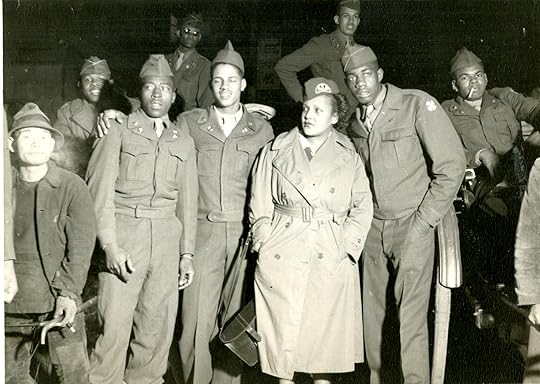
Ethel Payne with soldiers in Tokyo (Courtesy of the Moorland-Spingarn Research Center)
In my case, in the course of working on Eye on the Struggle, I learned for the first time the story of mixed-race babies in Japan born from African American soldiers and Japanese women in the years shortly after World War II when American troops occupied Japan. White soldiers fathered children as well, but the offspring of black fathers were far more ostracized.
Being of such visible mixed race, the babies were unwanted by the Japanese, who abhorred what they viewed as the tainting of their blood. They were frequently abandoned upon birth. In one case, a train passenger unwrapped a cloth bundle she spotted on the luggage rack to discover the corpse of a black Japanese baby.
Ethel Payne, the subject of my book, was working as a hostess in a black service club in Tokyo when she learned about these children. A friend took her to Yokohama to an orphanage run by the Franciscan Missionaries of Mary. There Payne learned about the abandoned children and was horrified. “Here were 160 foundlings of all mixtures, about 50 of them ‘Spookinese,’ Negro and Japanese,” said Payne. “Some beds had three babies they are so crowded.”
To military officials the infants, known as “occupation babies,” were none of their concern. It was forbidden to collect data on the extent of the problem and the subject was not to be publicly discussed. A reporter for the Saturday Evening Post had been expelled from the country for writing about occupation babies. Simply put, the subject was taboo. If blame was to be assigned, the military said it lay with licentious Japanese women who “made good clean American boys go morally wrong.”
Military law freed U.S. soldiers “of all but moral responsibility” unless they formally admitted paternity. But if the authorities were to push soldiers, specifically African American ones, to claim paternity or to marry a Japanese woman, it would challenge American opposition to mixed-race relationships and, more to the point, contradict existing prevailing state anti-miscegenation laws. As a result, the children of these relationships were regarded as pariahs by both societies, even more so in the case of those with black fathers.
There is very little that one can find out about what happened to these occupation babies born in Japan. On the other hand, in Germany the Black German Cultural Society was created in 1991 for Mischlingskinder, the German term for “brown babies.”
For more information and images, see http://afrogermans.us/.
 James McGrath Morris is the author of Eye on the Struggle: Ethel Payne, The First Lady of the Black Press and other books.
James McGrath Morris is the author of Eye on the Struggle: Ethel Payne, The First Lady of the Black Press and other books.
February 27, 2015
Slave Resistance in the Counter-Revolution of 1776
By Gerald Horne (Guest Contributor)
Though scholars and historians in the U.S. have been astringent critics to a greater or lesser degree of virtually all revolutions–French, Russian, Chinese, Cuban, etc.—there has been a stunning array of unity across the political spectrum, left to right, singing the praises of the revolt against British rule in 1776 leading to the formation of the United States of America.
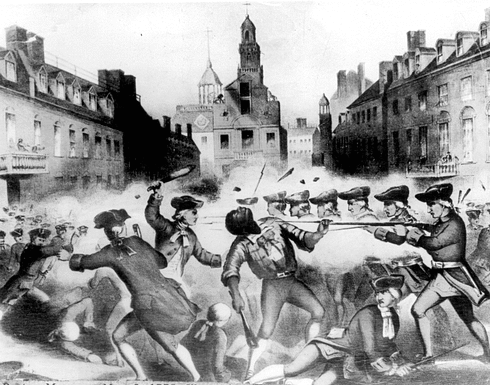
A Typical Representation of Slaves Supporting the Revolution
To gain a better understanding of this epochal revolt, the story should not begin in the 1770s–but, instead, with the so-called ‘Glorious Revolution’ in England in 1688; inter alia, this led to the undermining of the Royal African Company under the thumb of the Crown and the advance of the rising merchant class, as the profitable trade in enslaved Africans was “deregulated”, leading to “Free Trade in Africans.” At once this created great wealth that propelled capitalist relations in the colonies, making the latter more of an economic challenger to the metropolis headquartered in London but, also, accelerated slave revolts as the number of angry Africans grew exponentially.
As African rebelliousness grew, London was enmeshed in second thoughts about the viability of a colonial project based on slave labor. Moreover, in order to better confront competing empires–e.g. Spain–that were arming Africans, London could not rule out acting similarly, the prospect of which outraged the settlers pushing them toward revolt in 1776.
Incipient abolitionism in London and growing attraction to enslavement in the colonies led to a predictable result: it is well-known that by an order of magnitude Africans–ancestors of those now denoted as ‘African-American’–sided with London, not least since Britain was moving toward abolition of slavery as evidenced in ‘Somerset’s Case’ in 1772, a decision which outraged numerous North American settlers leading directly to the 1776 revolt.
“Somerset’s Case,” which involved the attempt by an African with roots in Virginia to gain freedom in England, seemed to suggest that the decision in his favor would lead to an extension of this abolitionist principle across the Atlantic to the North American colonies. This would jeopardize fortunes built not only on slavery and the slavery trade but, as well, the banking, insurance and shipbuilding enterprises–centered in e.g. New York, Rhode Island and Massachusetts–that underpinned the peculiar institution.
Today African-Americans suffer from all manner of ills–including one of the highest rates of incarceration in the world–yet the now archaic unanimity on the alleged virtues of 1776 hinders the ability of history to scrutinize the origins of what became a slaveholders’ republic then a Jim Crow regime in explicating this dire condition.
The Counter-Revolution of 1776 seeks to drive readers to a new understanding of a nation that touts its supposed revolutionary origins–yet has become the leading status quo power in the world, consonant with its less than heroic origins.
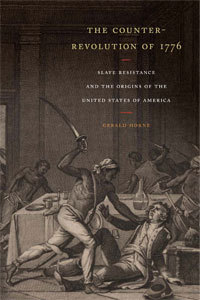 Gerald Horne is Moores Professor of History and African-American Studies at the University of Houston. His books include The Counter-Revolution of 1776: Slave Resistance and the Origins of the United States of America (2014), Race Woman: The Lives of Shirley Graham Du Bois, and Race War!: White Supremacy and the Japanese Attack on the British Empire
Gerald Horne is Moores Professor of History and African-American Studies at the University of Houston. His books include The Counter-Revolution of 1776: Slave Resistance and the Origins of the United States of America (2014), Race Woman: The Lives of Shirley Graham Du Bois, and Race War!: White Supremacy and the Japanese Attack on the British Empire
February 26, 2015
Slaves Identify Elephant Fossils in America
By Adrienne Mayor (Regular Contributor)
A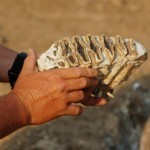 frican slaves dug up some colossal teeth while working in a swampy field on Stono Plantation (North Carolina) in about 1725. The English botanist Mark Catesby visited Stono to view the amazing discovery. His hosts, the plantation owners, told him that the great molars were all that was left of a giant victim of Noah’s Flood from the Bible. At that time, that was the common explanation for all oversized fossils in Europe and the American colonies. But Catesby also questioned the slaves on the plantation. He wrote that the “Opinion of all the Negroes, native Africans, who saw the teeth” was unanimous. These were the molars of a familiar animal from their homeland. The slaves insisted that the big teeth belonged to an elephant. Catesby agreed with the slaves. Unlike the white masters, Catesby had examined some enormous molars of an African elephant in a London museum.
frican slaves dug up some colossal teeth while working in a swampy field on Stono Plantation (North Carolina) in about 1725. The English botanist Mark Catesby visited Stono to view the amazing discovery. His hosts, the plantation owners, told him that the great molars were all that was left of a giant victim of Noah’s Flood from the Bible. At that time, that was the common explanation for all oversized fossils in Europe and the American colonies. But Catesby also questioned the slaves on the plantation. He wrote that the “Opinion of all the Negroes, native Africans, who saw the teeth” was unanimous. These were the molars of a familiar animal from their homeland. The slaves insisted that the big teeth belonged to an elephant. Catesby agreed with the slaves. Unlike the white masters, Catesby had examined some enormous molars of an African elephant in a London museum.
In Paris the famous French naturalist Georges Cuvier was intrigued by Catesby’s account. Cuvier was working on his new theory that huge fossils around the world belonged to prehistoric creatures, mammoths and mastodons. He was gathering evidence to show that these animals were the ancient ancestors of today’s elephants, and that they had all perished in a catastrophe ages ago. Cuvier was impressed, declaring that “les nègres” in America had correctly recognized a fossil elephant species before any European naturalist realized that extinct mammoths were related to living elephants.
The slaves at Stono were originally from Angola or the Congo, the habitat of living Loxodonta elephant species of Africa. The teeth they found at Stono belonged to a great Columbian mammoth that had died thousands of years earlier and was buried in the swamp. Mammoth teeth are flat with ridges (unlike the sharp, pointed teeth of mastodons) and they closely resemble the “grinders” of living African elephants. African people had often observed the skeletons, skulls, and teeth of elephants in Africa, and that experience allowed them to correctly identify the mammoth teeth in America. They must have been excited to find the remains of a familiar African animal so far from home.
About 50 years later, in 1782, workmen digging in salt marshes in Virginia unearthed teeth and “Bones of uncommon size.” Major Arthur Campbell sent these to Thomas Jefferson, with a letter saying that “Several sensible Africans have seen the tooth, particularly a fellow” owned by Jefferson’s neighbor. “All [the Africans] pronounced it an Elephant.” That means that the teeth belonged to a mammoth like at Stono, not to a mastodon. Once again, African slaves correctly identified the fossils that bewildered their white masters. Jefferson had a hard time accepting Cuvier’s idea that all that these behemoths were extinct. He wanted to believe that they still lived somewhere in the New World and hoped that Lewis and Clark would find herds of great American elephants grazing in the Northwest Territories.
About the author: Adrienne Mayor is a Research Scholar in Classics and History of Science, Stanford University. She is the author of “Fossil Legends of the First Americans” (2005); “The First Fossil Hunters: Dinosaurs, Mammoths, and Myths in Greek and Roman Times” (2011), and “The Poison King: The Life and Legend of Mithradates, Rome’s Deadliest Enemy,” a nonfiction finalist for the 2009 National Book Award.
The Color of Pirating
By Peter T. Leeson (Guest Contributor)
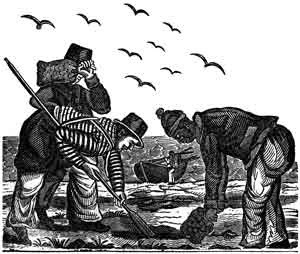 Eighteenth-century pirate features, from skull-emblazed flags to wooden legs, pervade popular culture. One important pirate feature that doesn’t appear in most pop-culture treatments, however, is the fact that upward of a quarter of the average early 18th-century pirate crew was black.
Eighteenth-century pirate features, from skull-emblazed flags to wooden legs, pervade popular culture. One important pirate feature that doesn’t appear in most pop-culture treatments, however, is the fact that upward of a quarter of the average early 18th-century pirate crew was black.
Historical evidence on the free vs. slave status of black pirates is conflicting. Because of this it’s tempting to conclude that pirates, who were no more racially enlightened than their legitimate contemporaries, typically treated blacks as their legitimate contemporaries did: they enslaved them.
But as I argue in my new book, The Invisible Hook: The Hidden Economics of Pirates, this conclusion may be mistaken. Although some black pirates were slaves, it’s probable that many, and perhaps even most, black pirates were not. To be sure, pirates were as prejudiced as their legitimate contemporaries. But unlike in legitimate society, in pirate society, prejudiced thinking didn’t necessarily mean prejudiced policy.
The reason for this is straightforward: pirates were profit seekers. They cared more about gold and silver than they cared about black and white. And granting blacks their freedom was often more profitable than enslaving them.
A pirate crew’s benefit of enslaving a sailor was the additional booty the slave’s wage-less labor brought it. But the crew’s cost of enslaving a sailor could be much higher. If the slave escaped and informed the authorities on his pirate captors, or together with other conscripts succeeded in overthrowing his enslavers and delivered them to the law, the pirates faced the unpleasant prospect of hanging and thus the end of their roguish lives. Since the cost of enslaving a sailor often exceeded the benefit, in many cases, granting black sailors their freedom was simply good business.
Pirate profit seeking, not progressivism, prodded some sea scoundrels to practice racial tolerance. But this doesn’t diminish the tolerance they showed. In their pursuit of self-interest these pirates were led, as if by an “invisible hook,” in some ways reminiscent of Adam Smith’s “invisible hand,” to treat black sailors as equals.
Peter T. Leeson is author of The Invisible Hook: The Hidden Economics of Pirates (Princeton University Press). Image courtesy of the author.
February 24, 2015
A Shocking Art Exhibition About Lynching
By Jack El-Hai, Wonders & Marvels contributor
Eighty years ago, racially motivated lynching in the U.S. was disturbingly common — there were 20 lynchings reported in 1935. Among its many activities intended to call attention to the injustice and brutality of these public murders, the National Association for the Advancement of Colored People (NAACP) sponsored an art exhibition in New York City. It was the first display of art in the U.S. organized around the themes of lynching and discrimination against African-American men. At the time, few galleries anywhere in America showed art by black artists or works that explored racial themes.

The 1893 lynching of Henry Smith, Paris, Texas
Titled An Art Commentary on Lynching, the show ran from February 13 through March 2, 1935, in the Arthur U. Newton Galleries in Midtown Manhattan. (Its home was originally to be the Jacques Seligmann Galleries, but the management there backed out.) It was a pet project of NAACP director Walter White, who wanted to build support for legislation to make lynching a federal crime.
The 38 artists whose works appeared in the exhibition included one woman (Peggy Bacon) and ten African Americans. White asked each of the contributors to focus on the violence of lynching, no matter how disturbing the result may be for visitors. And White got what he wanted: a collection of works laden with gore, terror, and hatred. (A few of the artists used milder religious imagery.) About 3,000 people took it all in.
Visitors saw John Steuart Curry’s lithograph The Fugitive, Isamu Noguchi’s sculpture Death, Harry Sternberg’s lithograph Southern Holiday, Thomas Hart Benton’s painting A Lynching, Wilmer Jennings’s linocut At the End of the Rope, and Peggy Bacon’s caricatures of infamous Southern judges, among other memorable works. Much of the exhibition’s featured art has not survived to the present day, and many of their creators have disappeared into obscurity.
White hoped that the creation and display of these artworks would heighten the public’s awareness of lynching and increase the general outrage. In the end, while his advocacy opened some eyes and generated a little news coverage it failed to bring about the passage of any federal anti-lynching legislation. His work to launch An Art Commentary on Lynching on a national tour also never came to fruition.
Further reading:
Dray, Philip. At the Hands of Persons Unknown: The Lynching of Black America. Random House, 2002.
Vendryes, Margaret Rose. “Hanging on Their Walls: An Art Commentary on Lynching, the Forgotten 1935 Art Exhibition,” published in Race Consciousness: African-American Studies for the New Century, edited by Judith Jackson Fossett and Jeffrey A. Tucker. New York University Press, 1997.
Lives of the Obscure: The Letters of a Cockney Match Factory Girl
By Seth Koven (Guest Contributor)
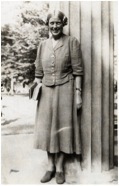
Muriel Lester, Courtesy of Bishopsgate Institute
The “lives of the obscure,” Virginia Woolf lamented, had a way of dissolving into the “fine mistlike substance of countless lives.” Woolf may have demanded histories of watercress and flower girls and yet this task she conspicuously never undertook. The Match Girl and the Heiress accepts Woolf’s challenge. It chronicles the remarkable partnership of Nellie Dowell (1876-1923), a half-orphaned Cockney match factory worker and Muriel Lester (1883-1968), the daughter of a wealthy ship builder and world-renowned pacifist humanitarian. In loving one another, these unlikely soul mates sought to inaugurate a Christian revolution on earth founded upon living by the precepts of the Sermon on the Mount. The bricks and mortar incarnation of their friendship was Kingsley Hall “people’s house,” Gandhi’s London slum home in 1931.
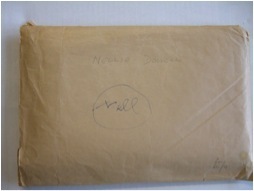
When I first consulted the Lester papers in Dagenham, Nellie’s letters were among the few items that Muriel appeared to have self-archived. This is a photograph of the tattered manila envelope in which she put Nellie’s letters.
I stumbled upon Nellie Dowell the very first day I traveled to Kingsley Hall’s Dagenham branch. There, I found a wrinkled manila envelope on which Muriel, in the unsteady hand of great old age, had written the word “Nell” and self-archived her friend’s witty tender letters to her. Full of chatty details about nephews and sisters, humorous asides about clutching a volume of Tolstoy as German “Zeps” darkened the wartime sky, and her longing for Muriel, Nellie’s letters mystified and delighted me.
By the time Muriel reread Nellie’s letters for the last time and put them back into their envelope, Nellie had been dead for decades. And Muriel had long since become a grande dame of social justice pacifism. Her life story had apotheosized into the stuff of Sunday school curricula. Muriel Lester Houses and Groups dotted the post-WWII American landscape. This only deepened my curiosity. Why did Nellie write these letters and why had Muriel cherished and preserved them?

Nellie Dowell to Muriel Lester, Lester Papers, Courtesy of Bishopsgate Institute. Nellie contrasts the formality of Muriel’s opulent family home in her posh suburb of Loughton with the welcoming informality of Kingsley Hall.
To answer these seemingly small questions about Nellie and Muriel’s entwined lives led me to write a big book about rather large historical questions. Nellie’s confinement in late-Victorian England’s most notorious barrack school orphanage at Forest Gate brought me face to face with what it might mean for a child to not have a childhood. I found myself writing a history of global capitalism at the dawn of the new century as I retraced Nellie’s mobile proletarian life as a match factory worker from the London slums to the shimmering hillsides of Wellington, New Zealand to Sweden and back again to London. The letters beckoned me into forgotten worlds of Christian revolutionaries and pacifist feminists, of poor law orphans in their soul-deadening blue serge uniforms and fierce match factory girls on strike for fair wages and a safe workplace.
But above all, these loving letters prompted me to think about the elasticity and power of love to change the world. At the root of this friendship was a radical reinterpretation of God not as an angry punishing Father but as devoted reconciling friend. These letters beckoned me to explore the intimate inner life of Muriel and Nellie’s project to use Jesus’s love – and their own — to build a New Jerusalem in the heart of a London slum free from the deforming hierarchies of class, sex, race and nation. That they often failed to achieve these utopian goals even in their own everyday lives – and that they knew and accepted their own and humanity’s imperfections – must be counted among this book’s most important lessons. The Match Girl and the Heiress is my story about theirs.
Virginia Woolf, “Lives of the Obscure,” in The Common Reader, First Series (London, 1925).
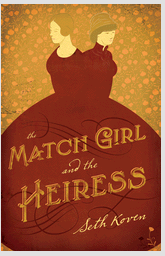 Seth Koven is Associate Professor of History at Rutgers University and the author of the recently published The Match Girl and the Heiress and Slumming: Social and Sexual Politics in Victorian London (2004).
Seth Koven is Associate Professor of History at Rutgers University and the author of the recently published The Match Girl and the Heiress and Slumming: Social and Sexual Politics in Victorian London (2004).
W&M is excited to have three (3) copies of The Match Girl and the Heiress for this month’s giveaway! Be sure to enter below by 11:00pm EST on February 28th to qualify (your entry includes a subscription to W&M Monthly).
Please note that, at this time, we can only ship within the US.
Monthly Book Giveaways
* indicates required
Email Address *
First Name
December Book Giveaways
Rebecca M. Herzig, “Plucked: A History of Hair Removal”
Michelle Moran, “Rebel Queen”
Seth Koven, “The Match Girl and the Heiress”



